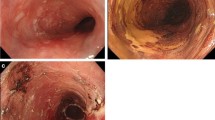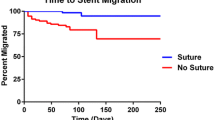Abstract
Objective
We aimed to evaluate the efficacy and safety of fully covered esophageal stent placement for preventing esophageal strictures after endoscopic submucosal dissection (ESD).
Methods
Twenty-two patients with a mucosal defects that exceeded 75 % of the circumference of the esophagus after ESD treatment for superficial esophageal squamous cell carcinomas were grouped according to the type of mucosal defect and randomized to undergo fully covered esophageal stent placement post-ESD (group A, n = 11) or no stent placement (group B, n = 11). In group A, the esophageal stents were removed 8 weeks post-ESD. Endoscopy was performed when patients reported dysphagia symptoms and at 12 weeks post-ESD in patients without symptoms. Savary–Gilliard dilators were used for bougie dilation in patients experiencing esophageal stricture in both groups, and we compared the rates of post-ESD strictures and the need for bougie dilation procedures.
Results
The proportion of patients who developed a stricture was significantly lower in group A (18.2 %, n = 2) than in group B (72.7 %, n = 8) (P < 0.05). Moreover, the number of bougie dilation procedures was significantly lower in group A (mean 0.45, range 0–3) than in group B (mean 3.9, range 0–17) (P < 0.05). The two patients in group A who experienced stricture also had stent displacement.
Conclusions
Esophageal stents are a safe and effective method of preventing esophageal strictures in cases where >75 % of the circumference of the esophagus has mucosal defects after ESD treatment for early esophageal cancer.


Similar content being viewed by others
References
Repici A, Hassan C, Carlino A, et al. Endoscopic submucosal dissection in patients with early esophageal squamous cell carcinoma: result from a prospective western series. Gastrointest Endosc. 2010;71:715–721.
Neuhaus H. Endoscopic submucosal dissection in the upper gastrointestinal tract: present and future view of Europe. Dig Endosc. 2009;21:S4–S6.
Radu A, Grosjean P, Fontolliet C, et al. Endoscopic mucosal resection in the oesophagus with a new rigid device: an animal study. Endoscopy. 2004;36:298–305.
Mizuta H, Nishimori I, Kuratani Y, et al. Predictive factors for esophageal stenosis after endoscopic submucosal dissection for superficial esophageal cancer. Dis Esophagus. 2009;22:626–631.
Ono S, Fujishiro M, Niimi K, et al. Predictors of postoperative stricture after esophageal endoscopic submucosal dissection for superficial squamous cell neoplasms. Endoscopy. 2009;41:661–665.
Katada C, Muto M, Manabe T, et al. Esophageal stenosis after endoscopic mucosal resection of superficial esophageal lesions. Gastrointest Endosc. 2003;57:165–169.
Ono S, Fujishiro M, Niimi K, et al. Long-term outcomes of endoscopic submucosal dissection for superficial esophageal squamous cell neoplasms. Gastrointest Endosc. 2009;70:860–866.
Isomoto H, Yamaguchi N, Nakayama T, et al. Management of esophageal stricture after complete circular endoscopic submucosal dissection for superficial esophageal squamous cell carcinoma. BMC Gastroenterol. 2011;4:46.
Yamaguchi N, Isomoto H, Nakayama T, et al. Usefulness of oral prednisolone in the treatment of esophageal stricture after endoscopic submucosal dissection for superficial esophageal squamous cell carcinoma. Gastrointest Endosc. 2011;73:1115–1121.
Ezoe Y, Muto M, Horimatsu T, et al. Efficacy of preventive endoscopic balloon dilation for esophageal stricture after endoscopic resection. J Clin Gastroenterol. 2011;45:222–227.
Kim JH, Song HY, Choi EK, et al. Temporary metallic stent placement in the treatment of refractory benign esophageal strictures: results and factors associated with outcome in 55 patients. Eur Radiol. 2009;19:384–390.
Wadhwa RP, Kozarek RA, France RE, et al. Use of self-expandable metallic stents in benign GI diseases. Gastrointest Endosc. 2003;58:207–212.
Song HY, Park SI, Do YS, et al. Expandable metallic stent placement in patients with benign esophageal strictures: results of long-term follow-up. Radiology. 1997;203:131–136.
Cheng YS, Li MH, Chen WX, et al. Temporary partially-covered metal stent insertion in benign esophageal stricture. World J Gastroenterol. 2003;9:2359–2361.
Matsumoto S, Miyatani H, Yoshida Y, et al. Cicatricial stenosis after endoscopic submucosal dissection of esophageal cancer effectively treated with a temporary self-expandable metal stent. Gastrointest Endosc. 2011;73:1309–1312.
Hashimoto S, Kobayashi M, Manabu T, et al. The efficacy of endoscopic triamcinolone injection for the prevention of esophageal stricture after endoscopic submucosal dissection. Gastrointest Endosc. 2011;74:1389–1393.
Hanaoka N, Ishihara R, Takeuchi Y, et al. Intralesional steroid injection to prevent stricture after endoscopic submucosal dissection for esophageal cancer: a controlled prospective study. Endoscopy. 2012;44:1007–1011.
Uno K, Iijima K, Koike T, et al. A pilot study of scheduled endoscopic balloon dilation with oral agent tranilast to improve the efficacy of stricture dilation after endoscopic submucosal dissection of the esophagus. J Clin Gastroenterol. 2012;46:e76–e82.
Mizutani T, Tadauchi A, Arinobe M, et al. Novel strategy for prevention of esophageal stricture after endoscopic surgery. Hepatogastroenterology. 2010;57:1150–1156.
Kim JH, Song HY, Park SW, et al. Early symptomatic strictures after gastric surgery: palliation with balloon dilation and stent placement. J Vasc Interv Radiol. 2008;19:565–570.
Dua KS, Vleggaar FP, Santharam R, et al. Removable self-expanding plastic esophageal stent as a continuous, non-permanent dilator in treating refractory benign esophageal stricture: a prospective two center study. Am J Gastroenterol. 2008;103:2988–2994.
Song HY, Jung HY, Park SI, et al. Covered retrievable expandable nitinol stents in patients with benign esophageal strictures: initial experience. Radiology. 2000;217:551–557.
Saito Y, Tanaka T, Andoh A, et al. Novel biodegradable stents for benign esophageal strictures following endoscopic submucosal dissection. Dig Dis Sci. 2008;53:330–333.
Nieponice A, McGrath K, Qureshi I, et al. An extracellular matrix scaffold for esophageal stricture prevention after circumferential EMR. Gastrointest Endosc. 2009;69:289–296.
Ohki T, Yamato M, Ota M, et al. Prevention of esophageal stricture after endoscopic submucosal dissection using tissue-engineered cell sheets. Gastroenterology. 2012;143:582–588.
Acknowledgment
This work was supported by Chinese Medical Sanitation Research Funds (11BJZ11).
Conflict of interest
None.
Author information
Authors and Affiliations
Corresponding author
Rights and permissions
About this article
Cite this article
Wen, J., Yang, Y., Liu, Q. et al. Preventing Stricture Formation by Covered Esophageal Stent Placement After Endoscopic Submucosal Dissection for Early Esophageal Cancer. Dig Dis Sci 59, 658–663 (2014). https://doi.org/10.1007/s10620-013-2958-5
Received:
Accepted:
Published:
Issue Date:
DOI: https://doi.org/10.1007/s10620-013-2958-5




